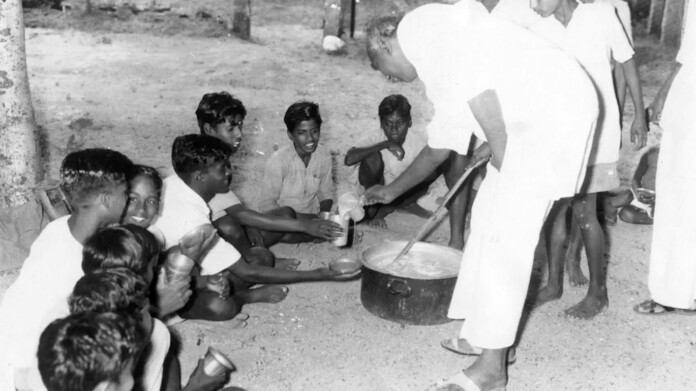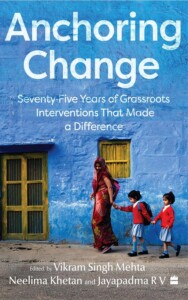This is an excerpt from a chapter written by Chandra Mohan and A.R. Meyyammai in “Anchoring Change: Seventy-five years of Grassroots Interventions that Made a Difference” edited by Vikram Singh Mehta, Neelima Khetan and Jayapadma RV, published by Harper Collins India. The book is a recipient of the GLF Honour Award 2023.
In 1956, poverty was rampant in India, with up to 73 per cent of the population in rural areas living below the poverty line and the number of children enrolled in schools was abysmal. The chief minister, K. Kamaraj, was acutely aware of how poverty and hunger were conspiring to keep children out of school. He sought to address the issue by introducing a hugely ambitious and transformational scheme of serving an afternoon meal in all schools of Tamil Nadu. Kamaraj overcame opposition from many quarters to ensure that the government started providing hot meals to students in schools. For many impoverished children, it often became the only meal of the day. School enrolments saw a dramatic increase.
Among the new students was Mahendran, who ran barefoot to the elementary school in his village early every morning. The noon meal at school not only satiated him but also gave him a respite from his strenuous work. The meal made it possible for Mahendran to break the shackles of hunger, go to school, study and reach for the skies. It was his ticket to freedom from hunger, illiteracy and deprivation and would go on to change his life forever. He went on to become the first post-graduate from his community. Mahendran says, ‘If the school had not served me a hot meal, there was no way I would have gone to school. I would have continued to wash clothes for a living.’
Like Mahendran, who went on to become the first post-graduate from his community in the village, many generations have benefitted immensely from this scheme, and it has changed the destiny of many from a life of stark poverty and hunger to dignity, self-respect and a life-changing education. The noon-meal scheme not only eradicated hunger from classrooms but also substantially improved student enrolment, retention and education levels in Tamil Nadu, laying the foundations for the state to emerge as an economic powerhouse.
Origins of the Noon Meal Programme
The early 1900s saw many swift and dramatic political and social developments in the then Madras Presidency. Established power structures were challenged, and long-suppressed communities found their voice with the self-respect movement gaining traction. The South Indian Liberal Federation, which would later go on to become the Justice Party — was responsible for ushering in many of these sweeping social and political changes in Tamil Nadu.
One of the Justice Party leaders was Sir P. Theagaraya Chetty, who also served as the president of Madras Corporation. He found that boys studying in a corporation school came from very poor families and constituted an insignificant proportion of the student population. After much deliberation, the Madras Corporation council passed a dramatically progressive resolution in November 1920: it would provide free tiffin to the students of the corporation school at the Thousand Lights area. The daily cost was capped at one anna per student. No one could have guessed that this small beginning would in years inspire one of the largest programmes for social transformation in the state.
Madras Corporation later made concerted efforts to introduce and expand the noon meal scheme and included four more schools. There was an increase in enrolments by children from poorer communities who were earlier reluctant to attend school. Policymakers were pleasantly surprised when the attendance in these five schools doubled in just two years—from 811 in 1922-23 to 1,671 in 1924-25.
However, the colonial British government played spoilsport by refusing to allot the required funds to support the scheme and it had to be suspended in 1925. Sustained pressure on the government from various quarters eventually forced it to revive the funding after two years. This time the scheme was further expanded to cover about 1,000 poor students in twenty-five schools in the city.
The Architect of the Noon-Meal Scheme
Kamaraj, who was appointed as chief minister in 1956, was deeply disturbed at the sight of malnourished and emaciated children when he visited a school in Madurai district. Despite the state facing a severe financial crunch, he immediately resurrected the noon-meal scheme in 1956 in an attempt to bring all children who remained out of classrooms to schools. Political commitment coupled with administrative leadership led to the scheme being successful. Buoyed by this, the government decided to provide midday meals to school children from poor families for 200 days a year.
The proposal initially sought to cover 65,000 students in all the primary schools in the state by establishing 1,300 feeding centres. The chief minister was strongly committed to expanding the scheme but the state’s financial situation was a major constraint. Undaunted and undeterred, Chief Minister Kamaraj made a fervent plea to the public to donate liberally to this project. A school in Nagalapuram was the first to embrace the scheme. Local philanthropists were more than happy to provide food free of cost to those children who attended school.
With the help of public donations, Kamaraj first introduced the scheme in government schools in Madras and later extended it to all districts. In 1956, the first state-sponsored school outside Madras implemented the scheme. It was in Ettayapuram, the village where the Tamil poet Subramania Bharati was born. Kamaraj found it appropriate to launch the scheme to honour the poet who had written the immortal lines: ‘Even if one person is deprived of food, we shall destroy the world.’
This was followed by many other initiatives by the state government—such as the distribution of free uniforms, which led to the revamping of the entire school education system. These measures laid a strong foundation for the state’s growth and development of education.
After Kamaraj, Chief Minister M. G. Ramachandran (MGR) extended the scheme to preschool children in the age group of two to five years in 1982. Later that year, children between five and nine years of age studying in primary schools in rural areas were also included. By 1984, the scheme had been extended to all children from age two to fifteen years studying in government (and government-aided) middle and high schools in both urban and rural areas.
Nationwide Application of the Scheme
The ‘Puratchi Thalaivar MGR Nutritious Meal Programme’ has emerged as a pioneering example for the rest of India. The Central government announced the ‘National Programme of Nutritional Support to Primary Education’ (NP-NSPE) on Independence Day in 1995. Initially implemented in 2408 blocks around the country, within two years the scheme was in force in all blocks in all states and union territories. In 2007, upper primary children were added to the programme.
In September 2021, the cabinet committee on economic affairs chaired by Prime Minister Narendra Modi approved a budget of Rs 1.31 trillion for the scheme to be in force at government and government-aided schools for the next five years. The programme has a special provision for providing supplementary nutrition to children in districts reporting a high prevalence of anaemia and other health issues.
The initiative started in just one school of Madras in 1920 has now not only continued for more than a hundred years but has also become one of the largest programmes of its kind in the world. The journey of a hundred years is a story interspersed with stellar milestones, each of which added substantial value to the programme and its sustainability.











